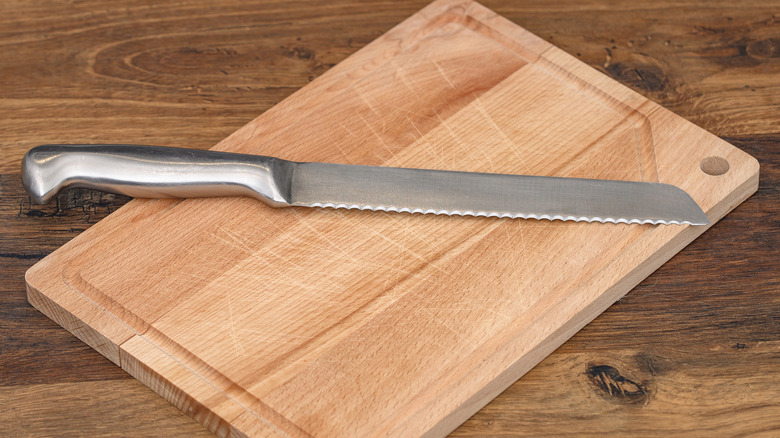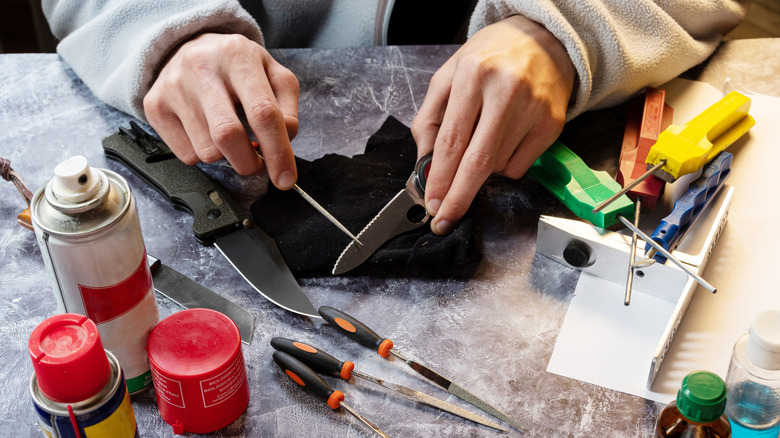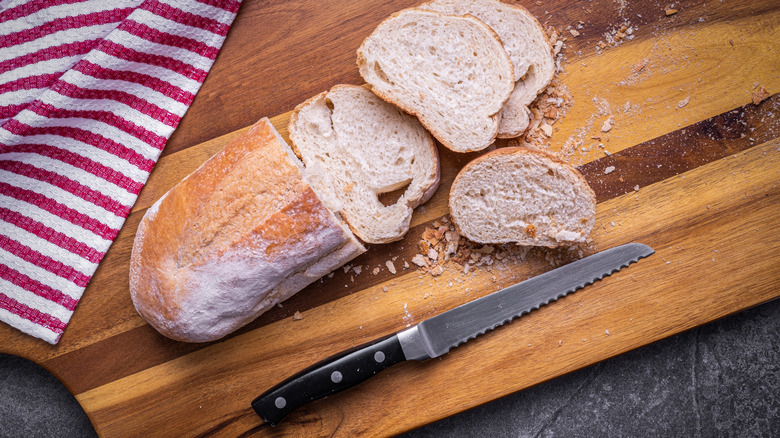How The Heck Do You Sharpen A Serrated Knife?
Sharpening knives can be an intimidating part of the kitchen experience for many home cooks. Not knowing the techniques, equipment, or the best serrated knives to buy can be a one-way ticket to crushed — not sliced — tomatoes, and even dangerous cooking accidents. But even for those who are comfortable sharpening their straight-edged knives, knowing how to sharpen a serrated knife can be a whole other ball game. That's why we spoke to Timo Horl, founder and CEO of HORL, the company that invented the original rolling knife sharpener design, to get some insights.
The first, and probably easiest, option, according to Horl, is seeking the services of a professional. "Sharpening serrated knives requires a special technique and tools specifically designed for this task," he says. "This type of blade is less made to be sharpened at home, so a professional service may well be worthwhile."
If you opt to do it at home, though, there is one crucial thing to consider: "The sharpening angle is crucial, as it directly affects a knife's sharpness, durability, and intended purpose," says Horl. "No matter which sharpening method you use, maintaining a consistent angle is key to achieving sharp, reliable results ... Most kitchen knives are sharpened at a 15- or 20-degree angle." Of course, if you are unclear on whether you have hit that mark, it is not the end of the world — just make sure that the angle you choose stays consistent throughout the process.
Sharpness is in the angle of the beholder
Timo Horl says that maintaining that constant angle, which is one of the most common mistakes among knife-sharpeners, requires a large amount of practice to become proficient at, but modern technology can help simplify the process. Once you've used the bread test to determine how sharp your knife is, then it's time to consider your equipment.
"When sharpening for the first time, we recommend using a guided system ... that keeps your knife securely in place at the right angle and gently removes material from the blade to restore sharpness," Horl says. If you're wondering why that would be necessary when you have got a perfectly good honing rod at home, Horl says the uses of such a tool are not as universal as you might think.
"The metal honing rod is not recommended for Damascus or Japanese knives, as improper use can quickly result in chips or damage to the edge," he says. "Japanese whetstones are particularly well-suited for this approach, as they come in varying grits to remove material delicately and achieve a new level of sharpness. However, this method requires considerable practical experience." If you're familiar with the many bread knife uses that go beyond the loaf, you'll understand exactly why it is so important to understand how to properly hone your blade.
Proper storage and honing techniques
After you have sharpened your blade, you need to ensure your work is put to its best use. "It's important to know that the sharpness doesn't last long, so the process needs to be repeated quite frequently," Timo Horl advises, especially when using a honing rod.
However, proper knife storage will allow you to at least get a little more bang for your buck with any type of blade. "Storing knives in a way that prevents their blades from touching each other or hard surfaces helps preserve their sharp edges and protects the blade from scratches and other damage," Horl says. "A well-cared-for knife can remain sharp and functional for years or even a lifetime, making it a worthwhile kitchen investment."
Part of caring well for your knife is understanding how much you want to remove during the sharpening process. "One mistake that some people often make when starting with knife sharpening is choosing a method that removes too much material from the blade or even chips it away," warns Horl. "These sharpeners can cause permanent damage to high-quality knives, which is why I always recommend using a sharpening method that removes material gently."



